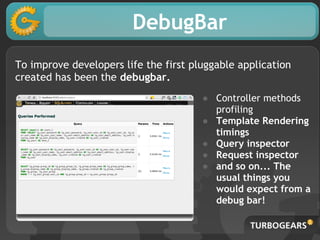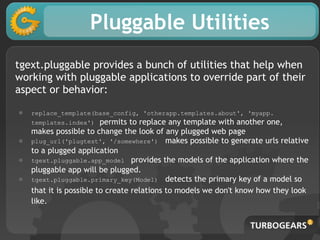Rapid Prototyping with TurboGears2
- 1. TurboGears2 Building Full Featured Web Applications with TurboGears2 in a bunch of minutes Alessandro Molina - @__amol__ - [email protected]
- 2. TurboGears2 ● Framework for rapid development encouraging customization ● Object Dispatch based. Regular expressions can get messy, never write a regex anymore ● By default an XML template engine with error detection ● Declarative Models with transactional unit of work ● Built in Validation, Authentication, Authorization, Caching, Sessions, Migrations, MongoDB Support and many more.
- 3. Looking at the code Serving /movie/3 as a webpage and /movie/3.json as a json encoded response class RootController(BaseController): @expose('myproj.templates.movie') @expose('json') @validate({'movie':SQLAEntityConverter(model.Movie)} def movie(self, movie, **kw): return dict(movie=movie, user=request.identity and request.identity['user'])
- 4. What it looks like
- 5. TurboGears for RAD ● 2.0 had sprox and tgext.crud: Flexible, but hard to use! ● 2.1 had many sprox improvements and added the EasyCrudRestController ● 2.1.4 had many hooks improvements that made tgext. pluggable possible! With EasyCrudRestController and pluggable applications rapid prototyping can be rapid for real
- 6. EasyCrudRestController Aims at making possible to create full administrative interfaces in a bunch of seconds
- 7. Easy CRUD Minimal setup is minimal for real! from tgext.crud import EasyCrudRestController class GalleriesController(EasyCrudRestController): model = model.Gallery This provides CRUD interface with Search, ordering and autogenerated JSON Rest API for that model.
- 8. Custom CRUD Customizing the Crud Controller can be done from the __form_options__ and __table_options__ variables of the class. class PhotosController(EasyCrudRestController): model = model.Photo allow_only = predicates.in_group('photos') title = "Manage Photos" keep_params = ['gallery'] __form_options__ = { '__hide_fields__' : ['uid', 'author', 'gallery'], '__field_widget_types__' : {'image':FileField}, '__field_validator_types__' : {'image':FieldStorageUploadConverter}, '__field_widget_args__' : {'author':{'default':lambda:request.identity['user'].user_id}} } __table_options__ = { '__omit_fields__' : ['uid', 'author_id', 'gallery_id', 'gallery'], '__xml_fields__' : ['image'], 'image': lambda filler,row: html.literal('‹img src="%s"/›' % row.image.thumb_url) }
- 9. Custom CRUD Result Result is a web page to upload photos to a gallery with uploaded image preview
- 10. Let's plug them all CRUD tools provide a quick and easy way to prototype new functions. But... there are things which are not a plain CRUD, how can you speed up their development? Fastest solution is to have things already done by someone else! That's what pluggable applications are for
- 11. Pluggables Pluggable applications provide ready made features that can be plugged into your applications. ● Implemented as tgext.pluggable, if you don't use them they won't bother you ● As easy as plug(base_config, 'appname') ● They look a lot like a plain application and provide models, controllers, templates, helpers, partials, database bootstrap and so on. ● Creating one as easy as paster quickstart-pluggable appname ● Sadly supported only for SQLAlchemy storage backed, mongodb planned
- 12. Available Pluggables tgapp-registration tgapp-smallpress Provides a registration Provides multblog with process with activation WYSIWYG editor, email. It's heavily tagcloud, attachments, customizable using drafts, future hooks. publications and Whoosh based search. tgapp-fbauth tgapp-photos facebook authentication, Provides partials to registration and display photos and connection to existing photo galleries with accounts. automatic thumbnails.
- 13. Available Pluggables tgapp-userprofile libacr Provides a basic profile Provides a powerful page and badge CMS where pages for users with profile are splitted into slices picture took from each editable facebook, gravatar or and of its own type. custom source. Custom slices and new type of contents stroller can be easily created directly from the CMS Provides eCommerce itself without editing application with code. categories, multiple pictures for each product and orders management.
- 14. DebugBar To improve developers life the first pluggable application created has been the debugbar. ● Controller methods profiling ● Template Rendering timings ● Query inspector ● Request inspector ● and so on... The usual things you would expect from a debug bar!
- 15. Inventing Mode How the debugbar relates to rapid prototyping? Well, it makes life easier, but mostly... It provides the inventing mode! Place your browser and code editor side by side and start experimenting, your changes will reflect into the browser in real time and it will notify you when you broke something.
- 16. Creating pluggables Once tgext.pluggable gets installed the quickstart-pluggable command becames available. Running quickstart-pluggable will create a package that looks a lot like a TurboGears application but provides a plugme method inside its __init__.py plugme method is the entry point of your pluggable application. def plugme(app_config, options): return dict(appid='plugtest', global_helpers=False)
- 17. Structure of a Pluggable $ paster quickstart-pluggable plugtest Pluggable Applications controllers, root controller of the application is named RootController inside the root.py file and will be mounted as /plugtest Models of the pluggable applications, will be bound to the session of the master app Static files of the pluggable application, will be available at /_pluggable/plugtest Templates of the pluggable application, controllers can use them with standard expose syntax: @expose('plugtest. templates.index')
- 18. Structure of a Pluggable Here rely all the utility functions of the pluggable application. By default they are not exposed to the master application but are stille accessible as a python module bootstrap is automatically called when initializing the database of the master application. Pluggables can provide helpers which will be automatically available into the master application as h.plugtest.helpername Partials are evolved helpers, they provide logic and look like controllers with an exposed template. They are acceissible inside templates with h.call_partial('plugtest.partials: partialname')
- 19. Pluggable Utilities tgext.pluggable provides a bunch of utilities that help when working with pluggable applications to override part of their aspect or behavior: ● replace_template(base_config, 'otherapp.templates.about', 'myapp. templates.index') permits to replace any template with another one, makes possible to change the look of any plugged web page ● plug_url('plugtest', '/somewhere') makes possible to generate urls relative to a plugged application ● tgext.pluggable.app_model provides the models of the application where the pluggable app will be plugged. ● tgext.pluggable.primary_key(Model) detects the primary key of a model so that it is possible to create relations to models we don't know how they look like.
- 20. Join [email protected] for more details!



![Looking at the code
Serving /movie/3 as a webpage and /movie/3.json as
a json encoded response
class RootController(BaseController):
@expose('myproj.templates.movie')
@expose('json')
@validate({'movie':SQLAEntityConverter(model.Movie)}
def movie(self, movie, **kw):
return dict(movie=movie, user=request.identity and request.identity['user'])](https://image.slidesharecdn.com/introducingturbogears2pluggableapplications1-120706051404-phpapp01/85/Rapid-Prototyping-with-TurboGears2-3-320.jpg)




![Custom CRUD
Customizing the Crud Controller can be done from the
__form_options__ and __table_options__ variables of the
class.
class PhotosController(EasyCrudRestController):
model = model.Photo
allow_only = predicates.in_group('photos')
title = "Manage Photos"
keep_params = ['gallery']
__form_options__ = {
'__hide_fields__' : ['uid', 'author', 'gallery'],
'__field_widget_types__' : {'image':FileField},
'__field_validator_types__' : {'image':FieldStorageUploadConverter},
'__field_widget_args__' : {'author':{'default':lambda:request.identity['user'].user_id}}
}
__table_options__ = {
'__omit_fields__' : ['uid', 'author_id', 'gallery_id', 'gallery'],
'__xml_fields__' : ['image'],
'image': lambda filler,row: html.literal('‹img src="%s"/›' % row.image.thumb_url)
}](https://image.slidesharecdn.com/introducingturbogears2pluggableapplications1-120706051404-phpapp01/85/Rapid-Prototyping-with-TurboGears2-8-320.jpg)











